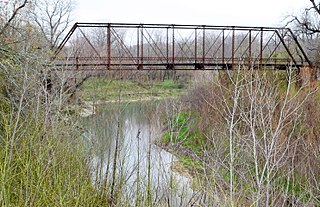Related Research Articles

The San Carlos Fortress is an 18th-century fortress in the city of Perote, in the Mexican state of Veracruz. It is also known as the Fort of San Carlos, Perote Castle, the Castle of San Carlos, Perote Prison, San Carlos de Perote Fortress, and San Carlos de Perote Castle.

The Little River is a river in Central Texas in the Brazos River watershed. It is formed by the confluence of the Leon River and the Lampasas River near Little River, Texas in Bell County. It flows generally southeast for 75 miles (121 km) until it empties into the Brazos River about 5 miles (8.0 km) southwest of Hearne, at a site called Port Sullivan in Milam County. The Little River has a third tributary, the San Gabriel River, which joins the Little about 8 miles (13 km) north of Rockdale and five miles southwest of Cameron. Cameron, the county seat of Milam County and the only city of any significant size on the Little River, was established in 1846.
Franklin Pierce Holland, was a publisher and the mayor of Dallas in 1895–1897.
Cundiff is an unincorporated hamlet in northeastern Jack County, Texas. The community is approximately 12 miles (19 km) northeast of Jacksboro. It was named for Harrell Cundiff, one of the first settlers of Jack County. There is a church there, and an outfitter, but no other businesses or services.

Wharton–Scott House, also known as Thistle Hill, is a historic mansion in Fort Worth, Texas.
Leon Creek is a tributary stream of the Medina River, in Bexar County, Texas.
Seco Creek, is a tributary stream of the Hondo Creek, in Frio County, Texas. Named Rio Seco in 1689 by Captain Alonso De León, governor of Coahuila, when his expedition crossed the creek.
Rancheros Creek is a tributary stream of the Sabinal River, in Medina County and Uvalde County, Texas.
Alexander Calvit (1784–1836) was an early settler in colonial Texas and a sugar planter. His Evergreen Plantation lay where the town of Clute, Texas, was later built.
The Tehuacana Hills are a series of hills in Limestone County, Texas.
Anne Valliant Burnett Tandy was an American heiress, rancher, horse breeder, philanthropist and art collector from Fort Worth, Texas.
The Dixon Creek is a creek in Texas.

Samuel Burk Burnett was an American cattleman and rancher from Texas, owner of the 6666 Ranch, and namesake of Burkburnett, Texas.

The 6666 Ranch is a ranch in King County, Texas as well as Carson County and Hutchinson County.
Thomas Lloyd Burnett (1871–1938) was an American rancher from Texas. He owned 449,415 acres of land.
Catlett Creek is a creek in Wise County, Texas.
Daniel Waggoner was an early American settler and rancher in Texas. He also owned five banks, three cottonseed oil mills, and a coal company. He established the Waggoner Ranch, which spanned eight counties: Wise County, Clay County, Wichita County, Wilbarger County, Foard County, Baylor County, Archer County, and Knox County. In 1959, he was inducted into the Hall of Great Westerners of the National Cowboy & Western Heritage Museum.
William Thomas Waggoner was an American rancher, oilman, banker, horsebreeder and philanthropist from Texas. He was the owner of the Waggoner Ranch, where he found oil in 1903. He was the founding president of the Waggoner National Bank of Vernon. He established the Arlington Downs and paid for the construction of three buildings on the campus of Texas Woman's University.
Peters Colony is a name applied to four empresario land grant contracts first by the Republic of Texas and then the State of Texas for settlement in North Texas. The contracts were signed by groups of American and English investors originally headed by William Smalling Peters. Samuel Browning, Peters' son-in-law signed the first contract with the Republic of Texas in Austin on August 30, 1841. Ownership of the empresario company changed many times during the life of the contracts.
References
- 1 2 3 "CHINA CREEK (WILBARGER COUNTY)," Handbook of Texas Online (https://tshaonline.org/handbook/online/articles/rbcdq), accessed November 14, 2014. Uploaded on June 12, 2010. Published by the Texas State Historical Association.
- ↑ Steve Wilson, Oklahoma Treasures and Treasure Tales, Norman, Oklahoma: University of Oklahoma Press, 1989, p. 192
- ↑ "WAGGONER, WILLIAM THOMAS," Handbook of Texas Online (https://tshaonline.org/handbook/online/articles/fwa09), accessed November 12, 2014. Uploaded on June 15, 2010. Published by the Texas State Historical Association.
- ↑ H. Allen Anderson, "WAGGONER RANCH," Handbook of Texas Online (https://tshaonline.org/handbook/online/articles/apw01), accessed November 12, 2014. Uploaded on June 15, 2010. Published by the Texas State Historical Association.
- ↑ "CHINA CREEK (SAN SABA COUNTY)," Handbook of Texas Online (https://tshaonline.org/handbook/online/articles/rbcdp), accessed November 14, 2014. Uploaded on June 12, 2010. Published by the Texas State Historical Association.
